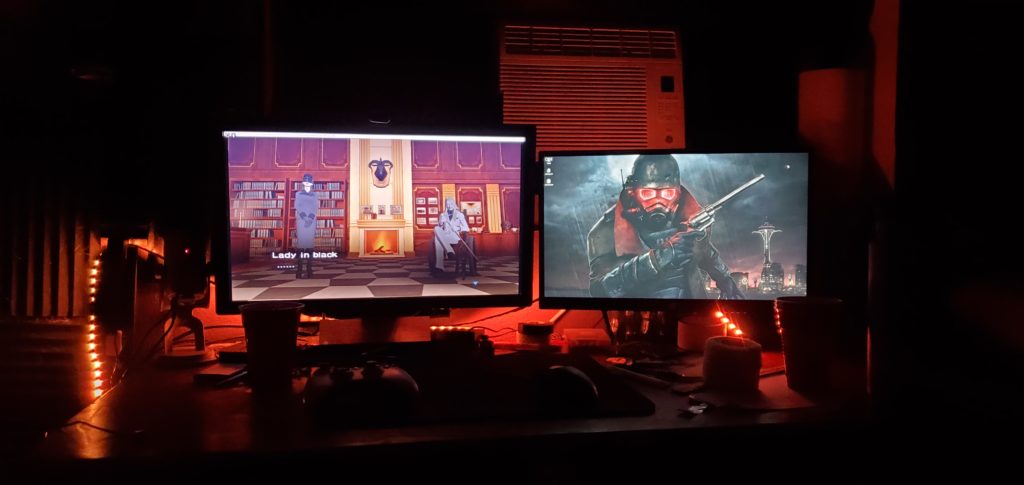Status: Complete
Type: Microcontroller
Technology: Arduino, PlatformIO, Arduino UNO, C++
In November of 2021 my interest in Arduino, something I had vaguely known of for years. It wasn’t until someone on Youtube who goes by Dave’s Garage made a video that showed up in my recommended feed going over the programming of WS2812B ARGB Strip lights. And so I promptly did my own in a Arduino Emulator which basically allows you to code everything without the physical hardware. Anyhow, the code is below.
Comet Effect
//Simple Comet Effect
//Designed for WS2812B LED strips,
//Tested on an Arduino Uno
//Using the FastLED Library
//Copyright William West 2021
#include <Arduino.h>
#include <FastLED.h>
#define STRIP_SIZE 120 // Length of the LED Strip
#define FPS 60 // Frames per second, speed is tied to FPS
CRGB leds [STRIP_SIZE]; // Creating the LEDS array
void setup() {
// put your setup code here, to run once:
// tell FastLED there's 30 NEOPIXEL leds on pin 9
FastLED.addLeds<NEOPIXEL, 9>(leds, 150);
}
int comet = 12; // Length of the Comet
int r = 255; // red
int g = 255; // green
int b = 0; // blue
int pos = 50; // Position of the Comet
bool dir = false; // Direction false = up, true = down
void loop() {
int trail = 1; // Iterator for dimming the trail
if (dir) // If going down
{
pos--; // Position goes downward
for (int i = pos; i < pos + comet; i++ ) { // Then start a for loop
FastLED.setBrightness(255/trail);//Setting brightness
if (i > -1 && i < STRIP_SIZE) { // Checking if we can draw
leds[i] = CRGB(r/trail,g/trail,b/trail); // Drawing
}
else
{
break; // Breaking the loop if we cant, reducing unecessary cpu use
}
trail++; // iterate trail
}
if (pos+comet+1 < STRIP_SIZE) //Checking if we're not at the edge
{
leds[pos+comet+1] = CRGB::Black; // If not clean the last pixel on the previous trail
}
}
else
{
pos++;
for (int i = pos; i > pos - comet; i--) {
FastLED.setBrightness(255/trail);
if (i > -1 && i < STRIP_SIZE) {
leds[i] = CRGB(r/trail,g/trail,b/trail);
}
else
{
break;
}
trail++;
}
if (pos-comet-1 >= 0)
{
leds[pos-comet-1] = CRGB::Black;
}
}
if (pos > STRIP_SIZE)
{
dir = true;
}
else if (pos < 0)
{
dir = false;
}
FastLED.show(); //This is what actually draws the leds on the strip.
delay(1000/FPS); // One second
}Fire Effect

//Simple Fire Effect
//Designed for WS2812B LED strips,
//Tested on an Arduino Uno
//Using the FastLED Library
//Copyright William West 2021
#include <Arduino.h>
#include <FastLED.h>
#define STRIP_LENGTH 150
CRGB leds [1][STRIP_LENGTH];
void setup() {
// tell FastLED there's leds on pin 9
FastLED.addLeds<WS2812B, 9>(leds[0], STRIP_LENGTH);
//Begin Serial output, platform IO likes 9600.
Serial.begin(9600);
}
void loop() {
//Initializing Random
srand((unsigned) millis());
//Getting a random chance the whole strip will flicker together
int wholeFlicker = rand() % 500;
for (int i = 0; i < STRIP_LENGTH; i++) //For loop to iterate through the strip
{
int flicker = rand() %10; //Testing if the individual LED will flicker
int mod = rand() % 55; // Modifier for the red
int mod2 = rand() %30; // Modifier for the green
int yolo = rand() %15; // Modifier for the blue
if (wholeFlicker !=250) // Testing if the strip should flicker
{
if (flicker != 1) // If we're not flickering
{//We're drawing the regular colors
leds[0][i] = CRGB(40+mod2, 200 +mod, yolo); //For some reason my strip processes color GREEN, RED, BLUE
}
else //Otherwise we're drawing dimmed colors
{
leds[0][i] = CRGB((40+mod2) - 40, (200 +mod) -10, 5);
}
}
else //If the whole strips flickering it'd be really dim
{
leds[0][i] = CRGB(0,20+yolo,0);
}
}
//This happens after we determine what the strip is doing this 'frame'
FastLED.show(); // Basically the print or render command
delay(20); //Wait 20 miliseconds to repeat
}Red White Blue
//Red White Blue
//Designed for WS2812B LED strips,
//Tested on an Arduino Uno
//Using the FastLED Library
//Copyright William West 2021
#include <Arduino.h>
#include <FastLED.h>
#define RED_PIN 7
#define BLUE_PIN 4
#define GREEN_PIN 5
CRGB leds [1][150];
void setup() {
// put your setup code here, to run once:
// tell FastLED there's 30 NEOPIXEL leds on pin 9
FastLED.addLeds<WS2812B, 9>(leds[0], 150);
Serial.begin(9600);
pinMode(RED_PIN, INPUT_PULLUP);
pinMode(BLUE_PIN, INPUT_PULLUP);
pinMode(GREEN_PIN, INPUT_PULLUP);
}
int start = 0;
void loop() {
int color = start;
int iterator = 0;
for (int i = 0; i < 150; i++)
{
if (iterator > 5)
{
iterator = 0;
color++;
if (color > 2)
{
color=0;
}
Serial.println("Color:");
Serial.print(color);
}
iterator++;
switch (color) {
case 0: leds[0][i] = CRGB::Blue; break;
case 1: leds[0][i] = CRGB::Red; break;
case 2: leds[0][i] = CRGB::White; break;
}
}
FastLED.show();
start++;
if (start > 3) {start = 0;}
delay(2000);
}